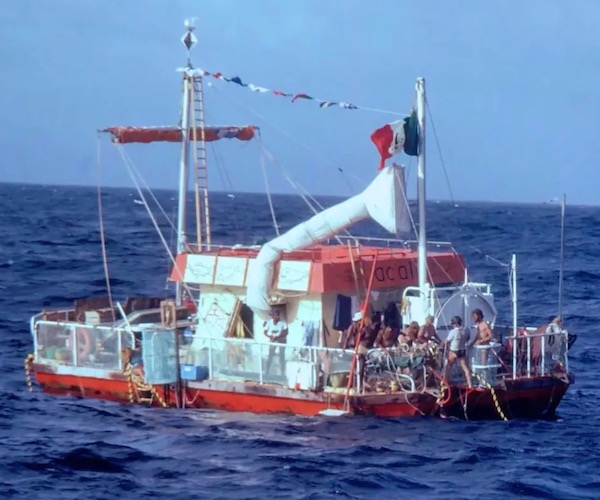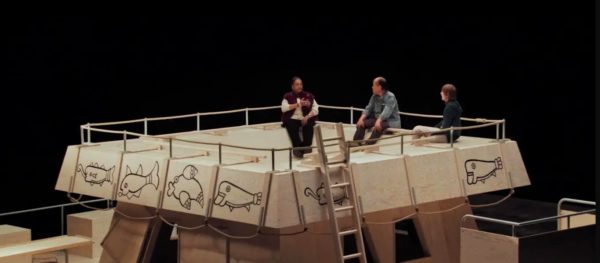Film Review: “The Raft” — An Illuminating Voyage
By Neil Giordano
What happens when a dubious scientific experiment yields unexpected results?
The Raft, directed by Marcus Lindeen. Screening as part of The DocYard series at the Brattle Theatre, Cambridge, MA, on June 10. The film will be streaming on digital platforms in late summer.

A scene from “The Raft.”
Here’s an elevator pitch: assemble a group of good-looking young people from different countries and of various ethnicities, set them adrift on a motorless raft on trade currents across the Atlantic Ocean for three months … and watch the sparks fly! No, it’s not the proposal for a network reality TV show inspired by The Love Boat. It is a real-life scientific experiment, conceived and carried out in 1973 by Mexican anthropologist Santiago Genovés. His goal: to understand the human proclivity for violence. The rewarding documentary The Raft looks back at the boat’s journey, via archival 16mm footage of the voyage, dramatic voiceover reenactment of Genovés diaries and notes and, most arrestingly, via a present-day, bare bones reconstruction of the raft itself on a soundstage. On the set, Lindeen assembles the surviving participants and asks them to reminisce on the meaning of the trip: the result is one of those truth-is-stranger-than-fiction tales. Like last year’s Three Identical Strangers, the narrative surprises you at every turn, not least because it serves up profound ruminations on social behavior, gender, and the capacity for humans to reconcile despite the strangest of experiences.
Lindeen brings a curious, but notably skeptical, sensibility to the history of the experiment, which the media sensationalized in the early ’70s. Dubiously nicknamed “the sex boat,” most observers feared (or hoped?) for news of a wild, non-stop 100 day orgy once the raft left the civilized confines of Europe on its way to Mexico. Genovés (who died in 2013) had spend his career studying the roots of human violence — always a timely topic, especially during the Vietnam War’s darkest days. He himself survived a plane hijacking, an experience that apparently gave him a new perspective on the stresses of captivity. So, despite his ridiculous methods, Genovés seriously out to answer some of anthropology’s elemental questions: Is violence innate or learned? Can it be tamed and/or regulated under certain conditions? Are men prone to violence and women drawn to peace?
But his experiment is revealed to be anything but scientific, a set-up that was flatly rejected by his peers before and after its inception. Among his non-scientific sins: he very specially selected the 10 participants (5 men, 5 women) for their relative desirability in order to create sexual and romantic rivalries; he concocted conflicts on the raft to put different people at odds with one another, notably by placing the women in positions of authority (the Swedish skipper was the youngest female ship captain in the world); and he insisted that the participants keep daily private journals and record their opinions of others. And, in a twist Big Brother would love, Genovés eventually read the letters aloud to the group when he was disappointed that there was not enough there to piss people off.

The soundstage in “The Raft.”
Exposing pseudo-science is not the point of The Raft, except to show how the law of unintended consequences can be a silver lining, even in an endeavor as botched as Genovés’. It turns out that the six surviving participants are the real finds — of both the experiment and the film. As they re-take their places on the soundstage model, they speak powerfully about their memories of each other and their experiences, their impressions of Genovés, and the fun and freedom they discovered at sea. Japanese photographer Eisuke Ramaki, the cameraman of the 16mm footage, provides some of the most touching and humorous moments. (There was sex! It was not memorable for anyone — but him!) Fe Seymour, the youngest shipmate — an American and the only black woman — notes how the power dynamics may have been stacked against her and the boat’s other people of color. She briefly reflects on a weighty realization; the trip connected her spiritually with her ancestors in the Middle Passage. The skipper, Maria Bjornstan, exudes a hesitant pride about her duties and remembers that the “macho” Genovés committed mutiny against her leadership.
The soundstage, reminiscent of Lars von Trier’s set for Dogville (is this a Scandinavian thing?) is an example of archly askew verisimilitude. Lindeen makes some odd directorial choices (I guess he had access to a wind machine?) that draw attention the self-conscious unreality of his present-day reenactment. Also, The Raft ends leaving some major threads dangling: what became of all these people once they reached Mexico? Did Genovés ever gain the respect of his colleagues again, or did he die in despair, seen by himself and others as a failure? Still, this documentary serves up a fascinating look back at the voyage of the “sex boat” — a trip that ended up disclosing some interesting things about human nature.
Neil Giordano teaches film and creative writing in Newton. His work as an editor, writer, and photographer has appeared in Harper’s, Newsday, Literal Mind, and other publications. Giordano previously was on the original editorial staff of DoubleTake magazine and taught at the Center for Documentary Studies at Duke University.

